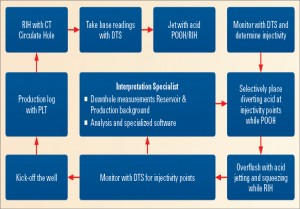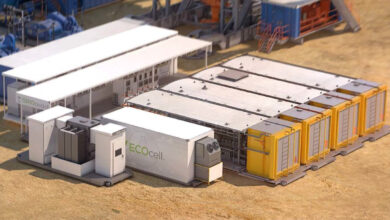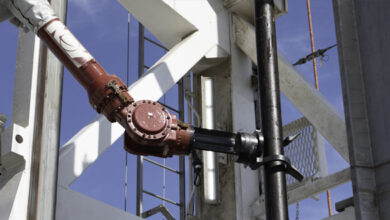CT logging service leverages powers of fiber-optic telemetry
High-bandwidth data measurements during production logging deliver critical downhole parameters
By Mubarak Dhufairi, Saudi Aramco; Vidal Noya, Schlumberger

Since its inception, coiled tubing (CT) has stimulated innovation because it brings massive hydro-mechanical power to the spot where the work is being done. Innovative minds have developed a myriad of applications for CT, and new ideas continue to surface. CT experienced a major breakthrough when it became possible to introduce electrical cable into the coil to power downhole tools.
However, with an armored cable inside the tubing, pump rates were restricted, and deployment of balls to actuate mechanical downhole components was complicated. Additional surface equipment was required to interface with the cable, and it was feared that the cable integrity could be compromised when acid was pumped. The idea of deploying two different CT strings — one for acid and one for production logging tools — was considered but rejected as impractical and uneconomic.
In 2008 Schlumberger introduced the ACTive live well performance coiled-tubing service based on fiber-optics telemetry. With this system, operators could obtain real-time measurements of critical job parameters from downhole during the treatment. A portfolio of ACTive applications includes matrix stimulation, perforating, cleanouts, nitrogen lift, conformance, fracturing and cementing.
More recently, the ACTive PS integrated coiled-tubing production service was introduced, which leverages the system’s telemetry capabilities to allow the conveyance of the most critical measurements commonly run with wireline services.
Saudi Aramco test case
In the Arabian Gulf, the M Field consists of 27 manmade islands connected by 25 miles of causeway. Water depth averages 4 ft to 6 ft. Most wells in the field are extended-reach, stretching laterally for up to 31,000 ft. Production is enhanced by massive flooding through power water injectors that employ 7-in. tubing and 6 1/8-in. barefoot completions up to 6,000 ft in length.
During drilling of the wells, every effort was made to protect the formations from mud filtrate invasion. A protecting wall cake lined the open hole, but once the drilling was completed, the wall cake needed to be removed before injection could commence. This was typically achieved by acid treatment using CT. A challenge, however, was preventing the acid from localizing in highly permeable zones once it broke through the mud cake, and as a result, failed to treat the injection zone uniformly.

Typically, a memory production logging (PL) string has been run on the end of the CT to gauge post-treatment distribution. However, this meant that the information from the tool was not available until after the tubing had been removed from the well. Because real-time PL results can be difficult to implement, and the operation increases the cost of the operation, the first challenge is ensuring the data quality of the memory log, as sometimes part of the information retrieved is not conclusive.
A second challenge was that, if the data indicated any untreated zones, the only solution was to re-enter the well and re-treat it. Since formation permeability and porosity vary greatly across the open-hole section, it was highly unlikely that a uniform treatment distribution could be achieved on the first attempt.
A delicate balance
The ability to obtain real-time data during treatment enables instant identification of problems while the CT work string is in the borehole and is able to address them. Moreover, if a high-permeability zone appears to be taking a disproportionate share of the treatment, diverters can be deployed to “steer” the treatment into untreated sections of the wellbore.
In some cases, only the porous and permeable zones within the open-hole section require treatment. Treating the entire open hole would waste a considerable volume of acid. By knowing where treatment is needed and where it is actually going, the job can be performed more efficiently and cost effectively.
In the past, downhole parameters had been extrapolated from surface pressure readouts with considerable inaccuracy. In addition, both the acid and the diverters are affected by downhole temperature variations. Accordingly, the availability of accurate, real-time pressure and temperature readings is a major benefit to treatment quality.
Injection treatment optimized
A natural evolution of e-coil, the replacement of the armored logging cable with a thin fiber-optic data conduit resulted in the development of Fiber Optic-Coil (FO-Coil) or ACTive, and introduced the ability to simultaneously perform extensive hydro-mechanical tasks with critical downhole measurements while monitoring all operations in real time.
In addition to the pressure, temperature and casing collar locator for depth correlation, the measurement includes a distributed temperature survey (DTS), which is instrumental to understanding fluid injection profiles and assisting their optimum placement.

The ACTive PS integrated coiled-tubing production service uses the same string for both stimulation and production logging interventions. The fiber-optic telemetry allows the BHA to communicate with the logging system, which provides real-time production logging data from the coiled tubing. This provides a means for looking at and treating stimulations with the same set of equipment but with one mobilization.
All PL data can be transmitted to surface in real time using the fiber-optic conduit, which allows the fiber to provide DTS. With a continuous DTS, zones that are taking the treatment will exhibit a clear temperature anomaly compared with zones that are not being treated, including zones that are above the acid injection head and the PL tools.
The 0.071-in. fiber-optic conduit is made up of four separate fibers and does not impede the deployment of drop balls to actuate mechanical completion equipment, such as sliding sleeves or junction valves. The fiber material is impervious to acid or hydrogen sulfide.
At the surface, the service company engineer can pull downhole data off the fiber terminal via wireless communication into a standard laptop computer to observe all parameters in real time in the CT control cabin. If special interpretation support is needed, all data can be transmitted via VSAT to a data support center anywhere in the world.
System integration software enables engineers to link all downhole events to formation properties and analyze observations with relation to actual downhole conditions. Treatment parameters can be adjusted at any time, including the deployment of diverters as required (Figure 1).
The ACTive PS system uses the FO-Coil string for telemetry and an 1 1/16-in. BHA, which powers and communicates with the conventional PL tools. Data are sent wirelessly from the working reel acquisition hardware to the acquisition software on surface; therefore, no conventional surface wireline logging unit is needed on location.
Successful first application
A candidate well in the M Field was selected for the first deployment of FO-Coil technology. The objective was to acid-treat a 3,500-ft open-hole section of a 12,560-ft well. A short injection test indicated a potential injection rate of 3,600 bbl/day of water at 2,000 psi. Post-treatment PL logs would indicate whether uniform distribution of the treatment had been achieved.
Three acid systems were designed. The first treatment consisted of a mutual solvent-based preflush to displace any hydrocarbon accumulation in the near-wellbore formations. Next, a 20% HCl wash containing corrosion inhibitors and surfactant would remove the wall cake and create “worm holes” in the carbonate matrix. An oil external phase emulsion featuring 20% HCl and diesel in a 70:30 ratio was developed with the objective of penetrating deeper into the formation before breaking.
Chemical diversion using viscoelastic diverting acid (VDA) provided an automatic self-diverting treatment. When the acid is expended, the VDA gels up, diverting the treatment to untreated zones. The fluid can be foamed using nitrogen to enhance its effectiveness in long horizontal intervals.
A step-by-step description is useful to understand the interaction between treatment and analysis:
• Pump preflush while running into the hole with CT.
• Perform warm-back DTS analysis to identify treatment zones.
• Bullhead injection test with real-time DTS injection profiling.
• Pump initial stimulation, including VDA diversion.
• Perform second bullhead injection test with real-time DTS.
• Pump second stimulation, including VDA diversion and emulsified acid while reciprocating CT into and out of the hole.
• Perform third bullhead injection test with real-time DTS.
• Pump down CT/tubing annulus using DTS to confirm flow to toe.
All bullheads were performed by pumping into the CT/tubing annulus. All treatments were performed while reciprocating the CT across the treatment interval. Up until this point, all logging was done using DTS.
After the final pumping phase, the CT was pulled out of the hole and a PL string was attached to the end and connected to the optical fiber. The PL string included gamma ray, casing collar locator, pressure/temperature gauges, tension/compression subs, a fullbore spinner, an inline spinner and an XY caliper.
In the well, the PL tool was run from casing shoe to total depth while pumping-in water at 10,000 bbl/day through the CT/tubing annulus. A total of 12 passes were performed – six while shut in and six while flowing. Station logs were performed while pulling back to the casing shoe. Using the FO-Coil to provide real-time PL data eliminated the lengthy and problematic process of time/depth calibration required of memory PL tools. In addition, real-time data enabled engineers to re-log any questionable zones.
Injection profiles obtained before, during and after treatment gave unprecedented insight into what was going on downhole. Fluid placement was optimized, exothermic acid reaction was monitored in real time to confirm effective acid fluids coverage, and clear indication of VDA performance was observed. More importantly, uniform treatment across the entire zone was confirmed.
The main benefit was obtaining a uniform profile leveraged on the new fluid placement strategy enabled by the DTS measurement. As an added benefit and innovation, this job marked the first time that a PL was done with fiber-optic coiled tubing in real time, as opposed to memory. The ACTive PS technology provides a multipurpose CT string that enables treatment and logging, providing real-time, high-bandwidth data measurements for the ability to make changes in processes to optimize results and minimize costs.
ACTive and ACTive PS are marks of Schlumberger.
This article is based on SPE 135200, presented at the 2010 SPE Annual Technical Conference & Exhibition, 20-22 September, Florence, Italy.




